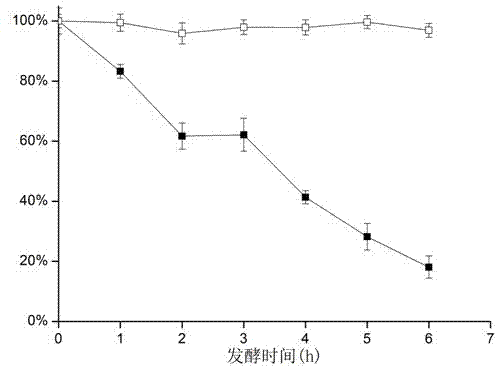Rhodotorula mucilaginosa capable of degrading urethane and its application in liquor products and food
A technology of urethane and red yeast, applied in the field of bioengineering, to achieve the effect of broad application potential
- Summary
- Abstract
- Description
- Claims
- Application Information
AI Technical Summary
Problems solved by technology
Method used
Image
Examples
Embodiment 1
[0023] Glue Rhodotorula capable of degrading EC ( Rhodotorula mucilaginosa ) Screening of CGMCC No: 5081 strain
[0024] The bacterial strains involved in the present invention are derived from the production of Maotai-flavored liquor such as 'Kouzijiao', 'Langjiu', 'Jinshiyuan', 'Maotai' and other rice wines, wheat koji from healthy mice Feces and feces of mice gavaged with EC (10 mg / kg / d). Shake a certain amount of the sample to be separated in sterile normal saline, inoculate an appropriate amount in 50mL enrichment medium with EC as the only carbon source, and add inorganic salts, shake culture at 30°C, 150rpm on a shaker, when the bacteria When the solution became turbid, the next transfer was carried out, and a stable bacterial solution that could use EC as the only carbon source was obtained through continuous acclimatization. Dilution coating was carried out on the solid medium in which EC was the only carbon source and an indicator was added, and a single colony cap...
Embodiment 2
[0027] Physiological and biochemical properties of the strain
[0028] Strain CGMCC No: 5081 does not ferment sugar, can assimilate glucose, sucrose, maltose, cellobiose, galactose, D-xylose, D-ribose, succinic acid, citric acid and other carbon sources, but cannot assimilate inositol, It can assimilate inorganic nitrogen sources such as ammonium sulfate, ammonium nitrate, and ammonium chloride, but cannot assimilate urea. The growth temperature range is 4-37 ℃, and the optimum temperature is 25-33 ℃; the growth pH range is 2.0-12.0, preferably 4.0-8.0; it can be grown in the environment containing 400g / L glucose, 2.0 mol / L KCl and 6% ethanol respectively. The environment is growing.
Embodiment 3
[0030] Glue Rhodotorula ( Rhodotorula mucilaginosa ) CGMCC No: 5081 strain aerobic degradation EC function
[0031] (1) Add 50mL seed medium to a 250mL Erlenmeyer flask. The medium components are: yeast extract (1%), peptone (1%), glucose (2%), potassium dihydrogen phosphate (0.25%), dihydrogen phosphate Ammonium (1%), Ammonium Sulfate (0.4%), Sodium Chloride (0.2%), Magnesium Sulfate Heptahydrate (0.05%), Zinc Sulfate Heptahydrate (0.02%), Ferrous Sulfate Heptahydrate (0.005%), Tetra Manganese sulfate hydrate (0.015%). In addition, ethyl carbamate or its analogues such as methyl carbamate, propyl carbamate, or amide compounds such as formamide, acetamide, butanamide, lactamide, N-methylacetamide, penicillin sodium, etc. are added naturally. pH: Inoculate the CGMCC No: 5081 strain obtained in Example 1 above, at 30°C, 150rpm, and carry out aerobic culture for 36-60 hours;
[0032] (2) Take the cultured bacterial solution in the above (1) and transfer the inoculation amount ...
PUM
 Login to View More
Login to View More Abstract
Description
Claims
Application Information
 Login to View More
Login to View More - R&D
- Intellectual Property
- Life Sciences
- Materials
- Tech Scout
- Unparalleled Data Quality
- Higher Quality Content
- 60% Fewer Hallucinations
Browse by: Latest US Patents, China's latest patents, Technical Efficacy Thesaurus, Application Domain, Technology Topic, Popular Technical Reports.
© 2025 PatSnap. All rights reserved.Legal|Privacy policy|Modern Slavery Act Transparency Statement|Sitemap|About US| Contact US: help@patsnap.com



